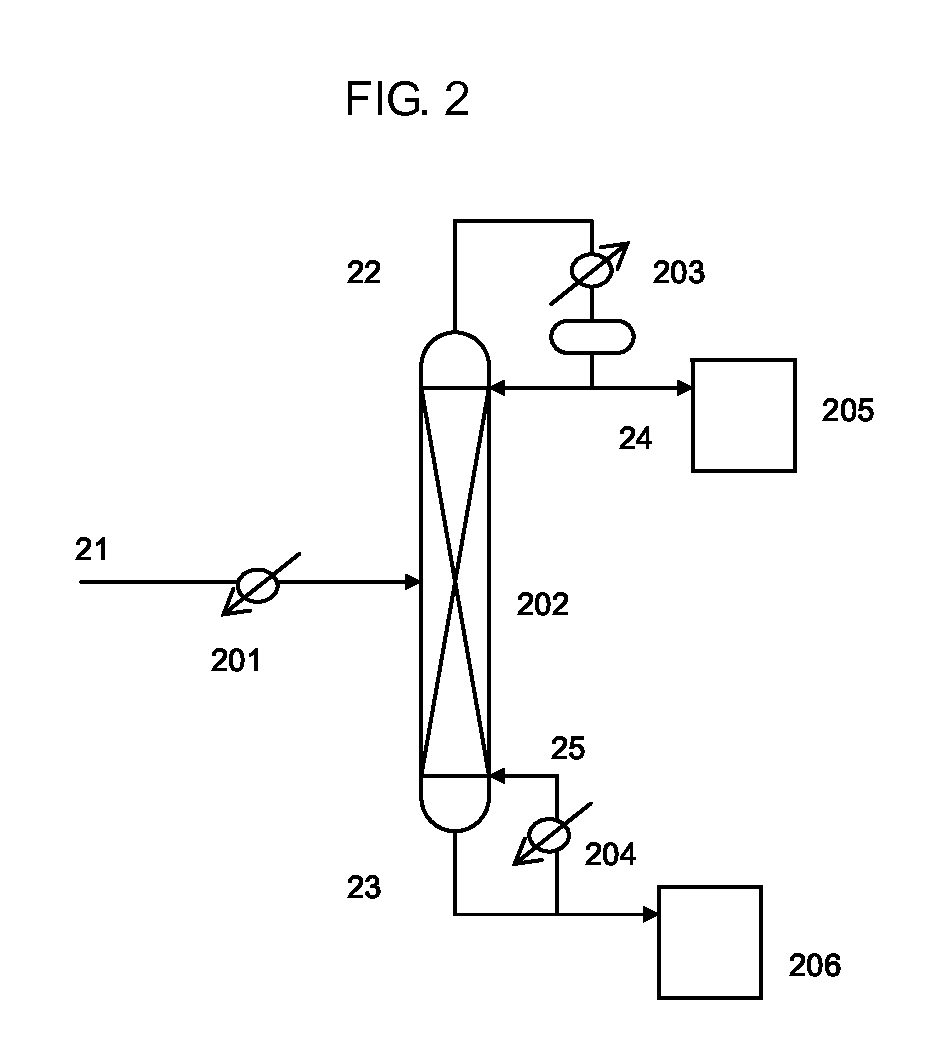Process for producing isocyanates using diaryl carbonate
a diaryl carbonate and isocyanate technology, applied in the preparation of isocyanate derivatives, preparation of carbamates, organic chemistry, etc., can solve the problems of not providing a detailed description of the process for continuously producing isocyanates, not being able to select reaction vessels and reaction conditions, and not being able to achieve the effect of efficient continuous production
- Summary
- Abstract
- Description
- Claims
- Application Information
AI Technical Summary
Benefits of technology
Problems solved by technology
Method used
Image
Examples
reference example 1
Production of Diphenyl Carbonate
Step (I-1): Production of Dialkyl Tin Catalysts
[0349]692 g (2.78 mol) of di-n-butyl tin oxide and 2000 g (27 mol) of 1-butanol (Wako Pure Chemical Industries, Ltd., Japan) were placed in a 3000 mL volumetric pear-shaped flask. The flask containing the mixture in the form of a white slurry was connected to an evaporator to which was connected an oil bath equipped with a temperature controller, a vacuum pump and a vacuum controller. The purge valve outlet of this evaporator was connected to a line containing nitrogen gas flowing at normal pressure. After closing the purge valve of the evaporator to reduce pressure inside the system, the purge valve was opened gradually to allow nitrogen to flow into the system and return to normal pressure. The oil bath temperature was set to be 126° C., the flask was immersed in the oil bath and rotation of the evaporator was started. After heating and stirring by rotation for about 30 minutes at normal pressure with t...
example 1
Step (1-1): Production of N,N′-Hexanediyl-bis-carbamic Acid Diphenyl Ester
[0370]A reaction was carried out using an apparatus like that shown in FIG. 7.
[0371]1350 g (6.3 mol) of the diphenyl carbonate of Reference Example 1 were supplied to baffled reaction vessel 704 made of SUS and having an inner volume of 5 L from storage tank 701 via line 71 with line 74 closed, and 987 g (10.5 mol) of phenol (Aldrich Corp., USA) were supplied to the reaction vessel made of SUS from storage tank 702 via line 72. The liquid temperature inside reaction vessel 704 was adjusted to about 50° C., and 244 g (2.1 mol) of hexamethylene diamine (Aldrich Corp., USA) were supplied to reaction vessel 704 from storage tank 703 via line 73 at the rate of about 200 g / hr.
[0372]As a result of analyzing the solution following the reaction by liquid chromatography, N,N′-hexanediyl-bis-carbamic acid diphenyl ester was found to have been formed at a yield of 99.5%.
[0373]Line 74 was opened and the reaction liquid was...
example 2
Step (2-1): Production of 3-(phenoxycarbonylamino-methyl)-3,5,5-trimethylcyclohexyl Carbamic Acid Phenyl Ester
[0385]A reaction was carried out using an apparatus like that shown in FIG. 7.
[0386]1992 g (9.3 mol) of the diphenyl carbonate of Reference Example 1 were supplied to baffled reaction vessel 704 made of SUS and having an inner volume of 5 L from storage tank 701 via line 71 with line 74 closed, and 1311 g (14.0 mol) of phenol were supplied to the reaction vessel made of SUS from storage tank 702 via line 72. The liquid temperature inside reaction vessel 704 was adjusted to about 50° C., and 528 g (3.1 mol) of 3-aminomethyl-3,5,5-trimethylcyclohexylamine (Aldrich Corp., USA) were supplied to reaction vessel 704 from storage tank 703 via line 73 at the rate of about 250 g / hr.
[0387]As a result of analyzing the solution following the reaction by liquid chromatography, 3-(phenoxycarbonylamino-methyl)-3,5,5-trimethylcyclohexyl carbamic acid phenyl ester was found to have been form...
PUM
| Property | Measurement | Unit |
|---|---|---|
| Temperature | aaaaa | aaaaa |
| Fraction | aaaaa | aaaaa |
| Fraction | aaaaa | aaaaa |
Abstract
Description
Claims
Application Information
 Login to View More
Login to View More - R&D
- Intellectual Property
- Life Sciences
- Materials
- Tech Scout
- Unparalleled Data Quality
- Higher Quality Content
- 60% Fewer Hallucinations
Browse by: Latest US Patents, China's latest patents, Technical Efficacy Thesaurus, Application Domain, Technology Topic, Popular Technical Reports.
© 2025 PatSnap. All rights reserved.Legal|Privacy policy|Modern Slavery Act Transparency Statement|Sitemap|About US| Contact US: help@patsnap.com



